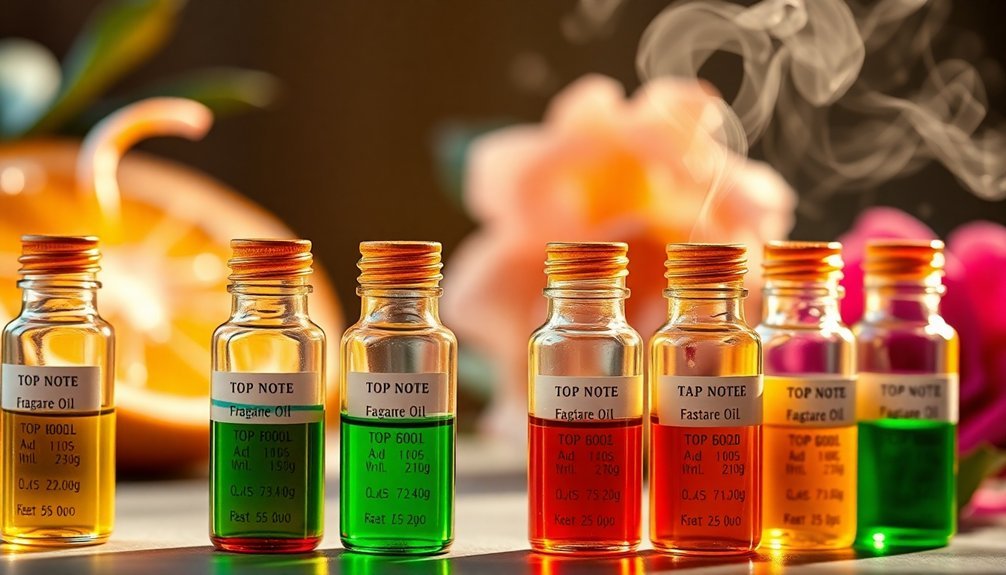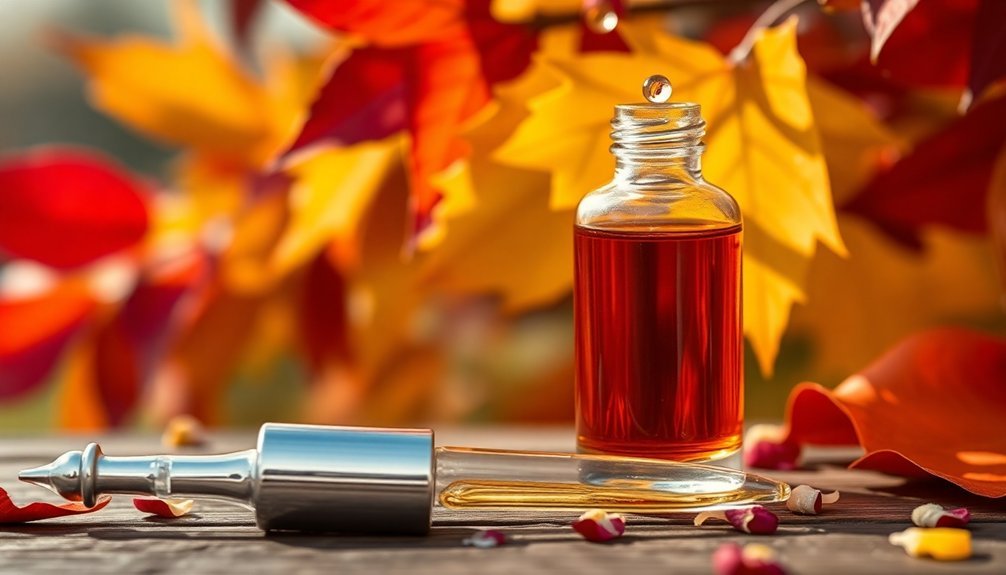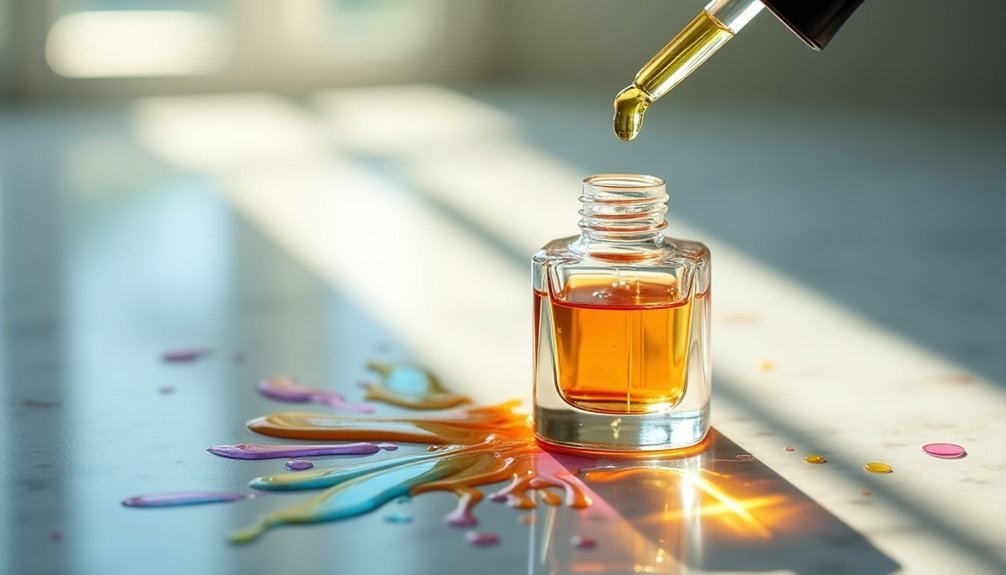For effective top note dilution ratios in perfumery, you'll want to maintain a 30% proportion of your total fragrance blend. Start with 1-2% dilution rates, using 3-12 drops per ounce depending on oil potency. Light citrus oils need fewer drops than herbal ones. Use 0.5% for light scents (3-4 drops), 1% for medium (6-8 drops), and 2% for strong oils (10-12 drops). The perfect blend awaits in the details of proper dilution.
Understanding Top Note Characteristics in Perfumery

Three essential qualities define top notes in perfumery: they're the first scents you'll experience, they evaporate quickly, and they create significant first impressions.
When you're working with fragrance oils and essential oils, you'll find that top notes typically last between 5 to 30 minutes after application, making up roughly 30% of your total blend.
You'll commonly encounter light, fresh ingredients like citrus and herbs in top note compositions.
These volatile components bring an uplifting quality to your fragrance while setting the stage for deeper notes that follow.
When you're crafting your blend, remember that top notes play a critical role in how people initially perceive your fragrance, so selecting the right balance of these fleeting yet impactful scents is important for a well-rounded perfume.
The Science Behind Top Note Dilution Ratios
When working with top notes, you'll need to carefully consider their evaporation rates, as these volatile compounds dissipate within the first 15 minutes of application.
You can measure top note strength by starting with 1-2% dilution ratios, typically using 3-12 drops per ounce depending on the oil's potency.
Understanding how to balance these fast-evaporating oils is essential, as stronger scents like citrus will require fewer drops than lighter ones to achieve the ideal 30% proportion in your final blend.
Evaporation Rates Matter Most
Understanding evaporation rates is essential to achieving the perfect dilution ratio for top note fragrances in your blends. When you're creating a fragrance blend, you'll need to account for how quickly different oils evaporate to maintain a balanced scent profile.
| Oil Type | Evaporation Speed | Recommended Dilution | Duration |
|---|---|---|---|
| Citrus | Very Fast | 25-30% | 15-20 min |
| Bergamot | Fast | 20-25% | 20-25 min |
| Floral | Moderate | 15-20% | 25-30 min |
| Herbal | Slow | 10-15% | 30+ min |
You'll want to use higher dilution ratios for faster-evaporating oils like citrus and bergamot to guarantee your top notes last beyond the initial application. Remember that top notes should make up about 30% of your overall blend to create a harmonious fragrance that flows smoothly through its phases.
Measuring Top Note Strength
The science of measuring top note strength relies heavily on precise dilution calculations to achieve the perfect initial impact.
You'll find that top notes generally perform best when they make up 20-30% of your total fragrance blend, following the established 30/50/20 rule.
When working with essential oils, you'll need to account for each oil's individual potency.
Strong top notes like bergamot require fewer drops than lighter citrus oils to achieve the same impact.
While higher concentrations can create a more vibrant opening, you'll want to avoid overdoing it.
The key is striking the right balance with your dilution ratios to prevent your fragrance from becoming too sharp or dissipating too quickly.
Balancing Volatile Compounds
Because volatile compounds evaporate quickly, mastering their dilution ratios becomes essential for creating lasting top notes in your fragrance blends.
When working with essential oils, you'll want to follow the 30/50/20 rule to guarantee your scents develop harmoniously over time.
- Keep your top notes at a 30% concentration to achieve the perfect initial impact without overwhelming the blend
- Aim for 10-20 drops of top note oils per 100 drops for ideal balance
- Maintain dilution ratios between 0.5% and 2% for citrus and peppermint essential oils
These precise measurements help you control the volatility of your top notes while creating a smooth shift to middle and base notes.
You'll find that careful attention to these dilution ratios results in more sophisticated and balanced fragrances that captivate from the first spray.
Essential Measurements for Top Note Blending
You'll want to start your top note measurements with citrus oils at 30 drops per 100-drop blend, ensuring you don't exceed the 2% dilution safety threshold.
When testing your head note strength, use fragrance strips to evaluate how quickly the scents evaporate and interact with other layers.
The quick-evaporation nature of top notes means you should observe their performance within the first 15-30 minutes of application to gauge proper balance.
Citrus Oil Blending Basics
When creating enchanting fragrances, citrus oils serve as essential top notes that deliver an immediate burst of freshness to your blend.
To master essential oil blending, you'll need to follow specific dilution ratios of 3 to 12 drops per ounce, keeping citrus oils between 0.5% to 2% of your total mixture.
For a well-balanced fragrance, remember these key guidelines:
- Combine equal parts of Bergamot, Lemon, and Grapefruit for a vibrant top note profile
- Follow the 30/50/20 rule: 30% top notes, 50% middle notes, and 20% base notes
- Balance bright citrus notes with middle and base notes for longer-lasting wear
These measurements guarantee your citrus-based fragrances maintain both safety and effectiveness while providing that perfect opening note that captures attention.
Measuring Head Note Strength
Building upon the citrus oil foundation, mastering head note measurements brings precision to your fragrance creation process. You'll want your top notes to make up about 30% of your blend, using 10-20 drops of essential oils per 5ml of perfume.
| Top Note Type | Drops per 5ml | Strength Level |
|---|---|---|
| Light Citrus | 10-12 drops | Subtle |
| Floral | 13-15 drops | Moderate |
| Herbal | 16-20 drops | Strong |
When measuring your blend, stick to two or three complementary top notes to avoid overwhelming the fragrance. Test your combinations on fragrance strips to evaluate their strength and harmony. Remember, you can always adjust the ratios based on your preference and the specific essential oils you're using. This careful measurement approach guarantees your top notes create the perfect initial impression.
Quick-Evaporation Rate Guidelines
Understanding evaporation rates stands at the core of successful top note blending. When you're working with top notes, you'll need to carefully manage their quick-evaporating nature to maintain fragrance integrity.
Start by following the 30% rule for total oil composition while diluting your blend to 2% of the final volume.
To effectively test your blending essential oils, use these key guidelines:
- Apply your blend to fragrance strips and evaluate the scent after a few minutes
- Keep citrus oils like bergamot and lemon at appropriate dilution levels to prevent overwhelming the blend
- Monitor the initial scent impact, which typically lasts between a few minutes to an hour
These measurements guarantee your top notes contribute the right amount of freshness without dominating the overall fragrance profile.
Matching Top Notes With Carrier Oils
The art of matching top notes with carrier oils requires careful consideration of both scent intensity and oil compatibility.
You'll want to select light carrier oils like fractionated coconut or sweet almond oil, as they won't overpower your delicate top notes.
When creating your blend, keep your dilution ratios between 0.5% and 2% of the total mixture to guarantee skin safety.
You should aim to use top notes for 10-30% of your overall fragrance composition to maintain their distinct presence in the scent profile.
Before finalizing your blend, test the combination on fragrance strips to verify that your chosen carrier oil complements your top notes effectively.
This step helps you confirm both the scent strength and the harmony between your oils.
Balancing Citrus and Herbal Top Notes

When working with citrus and herbal top notes, you'll need to account for the strength differences between light citrus oils and more potent herbal essences.
You can adjust your blend ratios seasonally, using more citrus in summer months and increasing herbal components during winter to maintain ideal fragrance impact.
Following the 30/70 citrus-to-herbal ratio will help you create balanced blends while allowing room for seasonal adaptations.
Light Vs Strong Oils
Balancing light and strong oils requires careful attention to proportions, especially when working with citrus and herbal top notes.
You'll want to follow the 30/50/20 rule, where top notes make up 30%, middle notes 50%, and base notes 20% of your blend.
To achieve the perfect balance, consider these key ratios:
- Use lighter citrus oils like bergamot and lemon at 30% of your top note portion to create a fresh, inviting opening
- Limit stronger citrus oils such as grapefruit to 10-15% to prevent them from dominating the blend
- Keep herbal elements like peppermint and basil between 5-10% to complement rather than overpower
Test your blend using fragrance strips to verify the lighter and stronger oils work harmoniously together, creating a well-rounded scent profile.
Seasonal Note Adjustments
Seasonal changes call for thoughtful adjustments to your citrus and herbal top note ratios.
In warmer months, you'll want to blend 60% citrus oils like bergamot and grapefruit with 40% herbal notes such as basil and mint. This combination creates a rejuvenating balance while the herbal elements provide a cooling effect.
When winter approaches, shift your focus toward herbal top notes like rosemary and thyme, maintaining just a hint of citrus for brightness. You might pair lemon with sage to create a festive winter ambiance.
Whatever seasonal adjustments you make, remember to let your blends rest for 48 hours before finalizing them. This waiting period guarantees your citrus and herbal notes properly integrate, resulting in a well-balanced fragrance that's perfectly suited to the season.
Creating Signature Top Note Combinations
Creating signature top note combinations begins with selecting complementary scents that make a memorable first impression.
You'll want to blend two to three essential oils while keeping the total dilution under 3% of your finished product – that's about 3-12 drops per ounce.
- Mix citrus oils like bergamot and lemon for an invigorating burst
- Combine floral and fruity notes, such as jasmine with orange, for unique profiles
- Layer different citrus varieties to create depth while maintaining freshness
Since top notes make up 30% of your fragrance and evaporate quickly, it's vital to strike the right balance.
Experiment with various combinations until you find your perfect signature blend.
Remember that these volatile oils set the initial tone for your fragrance, so choose wisely to create that perfect first impression.
Seasonal Adjustments for Top Note Strength

When adjusting your top note strength throughout the year, you'll need to contemplate how temperature and humidity affect fragrance perception.
During summer months, increase your top notes, especially citrus-based ones, to combat heat and provide invigorating qualities. The dilution ratio should stay within 0.5% to 2% of your total blend, translating to 3-12 drops per ounce of fragrance oils.
In winter, opt for warmer, spicier top notes while maintaining balance with stronger middle and base notes. This creates a cozy feel without sacrificing the fresh opening.
Remember to test your blends across different seasons, as environmental factors notably impact how your top notes perform. You'll find that strategic seasonal adjustments help maintain the perfect balance in your fragrance throughout the year.
Common Top Note Blending Mistakes to Avoid
Mastering top note blending requires careful attention to avoid several critical pitfalls. When creating your fragrance, you'll need to be mindful of proper ratios and testing procedures to achieve a balanced blend.
- Keep your top notes at around 30% of the total blend to guarantee a harmonious shift to middle and base notes.
- Test your fragrance on strips and allow proper resting time, as initial impacts can be deceiving.
- Avoid overloading your blend with too many top notes, which can create an overwhelming initial scent.
Remember that strong top notes can easily dominate your fragrance if used excessively.
Perfecting Your Top Note Percentages

The art of achieving perfect top note percentages requires a delicate balance of precision and experimentation. When crafting your blend, aim for top notes to comprise 30% of your total fragrance composition. You'll want to dilute your essential oils to 0.5-2% concentration, using 3-12 drops per ounce of finished product.
| Note Type | Percentage | Drops/oz |
|---|---|---|
| Light | 0.5% | 3-4 |
| Medium | 1% | 6-8 |
| Strong | 2% | 10-12 |
Since top notes evaporate quickly, you'll need to complement them with middle and base notes for staying power. Try working with citrus oils like Bergamot or Lemon to create invigorating initial impressions. Remember to test your blend repeatedly, adjusting percentages until you achieve the perfect balance without overpowering the deeper notes.
Testing and Adjusting Top Note Potency
Now that you've established your initial top note percentages, accurate testing becomes the key to perfecting your blend. Start with a 1-2% dilution of essential oils, using 6-12 drops per ounce of carrier oil. Test your creation using fragrance strips or cotton wool balls, making sure to waft them from a distance to protect your nose from fatigue.
When creating a blend, follow these essential steps:
- Begin with the minimum recommended drops and increase gradually
- Allow your blend to rest for several days to observe scent evolution
- Document all ratios and adjustments for future reference
Remember that top notes are highly volatile, so you'll want to evaluate how they perform over time. Keep adjusting drop by drop until you achieve the perfect balance with your middle and base notes.
Frequently Asked Questions
What Is the 30 50 20 Rule for Perfume?
You'll create a balanced perfume by following the 30-50-20 rule: use 30% top notes for initial scent, 50% middle notes for the core, and 20% base notes for lasting fragrance.
What Fragrance Notes Go Together?
You'll find that citrus pairs well with floral notes, while spicy notes complement woody scents. Try combining sweet orange with jasmine, or bergamot with vanilla. Lavender works nicely with most other fragrances.
How Much Should Fragrance Oil Be Diluted?
You'll want to dilute fragrance oils to 0.5-2% concentration for general use, which means using 3-12 drops per ounce. For perfumes, you can go up to 5% to create a stronger scent.
What Percentage of Top Middle and Base Notes Should I Use?
You'll want to follow the standard perfume ratio: use 30% top notes for initial impact, 50% middle notes for the main character, and 20% base notes for depth and lasting power in your blend.
In Summary
You'll find that mastering top note dilution ratios takes practice and patience. Start with the recommended percentages, but don't be afraid to adjust based on your specific fragrance goals. Keep detailed notes of your successful ratios, and remember that weather conditions can affect your final results. When you've found your perfect balance, you'll create consistent, professional-quality top notes that lift your entire fragrance composition.





Leave a Reply